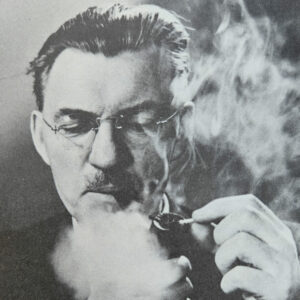
He was known as the man who could make or break a literary career. His years as literary editor, first at Saturday Night magazine and then the Globe and Mail, from 1922 until his retirement in 1960, brought him in close contact with Canadian cultural heavyweights like Hugh MacLennan, Stephen Leacock, Mazo de la Roche and Lawren Harris. His name was William Arthur Deacon, and he was a jumble of contradictions, but unwavering in his belief in his own destiny, his support for Canadian literature and his love for Leaside.
Born in Pembroke in 1890, he trained in and briefly practised law in Manitoba but left the legal profession, finding it a bore and proclaiming that the decade in Dauphin represented “the 10 lost years of his life.” Raised a Methodist, at the age of 26 he discovered a new “religion”: theosophy. It was a “muscular mysticism” with elements of Hinduism and Buddhism to it which promoted the idea of everyone’s having a destiny, with his being a writer and helper of Canadian talent. In the book Deacon: A Canadian Literary Life, we learn that “he held as axiomatic the belief that Canadians were a vital and dynamic people who would require, demand, and produce a correspondingly dynamic literature.”
Deacon was a promoter of French-Canadian literature, and a fan of writers like Gabrielle Roy, author of the Tin Flute. He wrote to her that he was “a literary parasite, who depends for a living on knowing people like you.” Heaven help the writer who found herself on the wrong side of Deacon, however. Lucy Maud Montgomery, author of the Anne of Green Gables books, was one such novelist. Some say there was a tinge of jealousy (his books sold in the hundreds; hers were international bestsellers) which caused him to write: “As for the girls’ sugary stories begun with Anne of Green Gables… Canadian fiction was to go no lower.”
For 33 years he called Leaside home. In 1936 he moved his young family into the newly built 66 Parkhurst Blvd. True to his “faith,” he had the emblem of theosophy inscribed onto the basement floor. The handsome home still stands but is at risk of being demolished, although there is an application to have it listed on the City’s Heritage Register. In fact, this part of Parkhurst was nominated for Heritage Conservation District status in 2012, but that effort failed. Perhaps now is a good time for the community to try again? In 1954, Deacon moved to 48 Killdeer Cres. in North Leaside and remained there until 1969.

Clearly a proud Leasider, he would pepper his articles in the Globe and Mail with complimentary quips. In an article dated April 5, 1958, discussing the challenges of providing library services in a booming Toronto, he said: “Leaside is a town in which things get done, not just talked about.” In an interview with the Globe and Mail’s Ronald Haggart, Deacon said: “I have had the privilege of being a Leasider for more than 20 years, and I like it there. The town is not fashionable. Our boast is that we are decent, middle-class folk who hold their jobs and pay their debts.” Modest and understated, his ways seemed to jibe with the town’s no-nonsense moral code. Perhaps it is now our responsibility to brag about Deacon, a Canadian literary icon, and preserve his memory on Parkhurst Boulevard.
Images from William Arthur Deacon: A Canadian Literary Life by Clara Thomas and John Lennox 1982.
This article was guest contributed by Mitch Bubulj.


